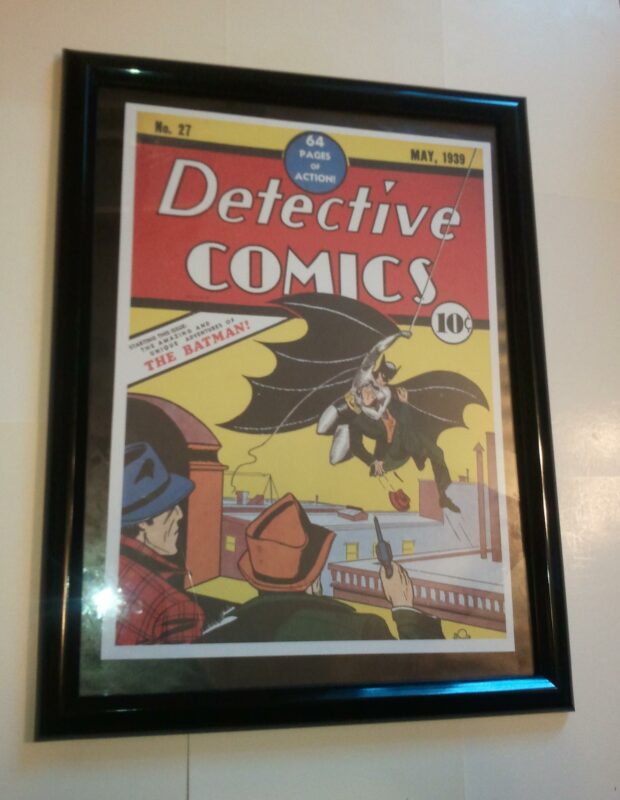Description
You are purchasing the item pictured, framed. Priority mail, tracking and $50 insurance is included with purchase. Item will be bagged to protect from dust, packed in packing peanuts and boxed. Just open box and hang it on the wall…makes a perfect gift!
Superman was just the beginning. Less than a year after the Man of Steel’s debut, DC hit the jackpot once again with the introduction of a second soon-to-be-internationally-iconic hero- Batman (or the Batman, as the cover of Detective Comics #27 proclaimed him, or the “Bat-Man,” complete with quotation marks and a hyphen, as the interior pages insisted on calling him). Before the advent of the Caped Crusader, Detective Comics had been a curious anthology of hard-boiled private-eye stories (the “D” in DC stands for “detective,” in fact), often featuring stereotypical Asian masterminds as villains. Within a year, Batman had taken over the series. Creator Bob Kane and writer Bill Finger based the character of Batman in part on Douglas Fairbanks’ portrayal of Zorro, with elements of Lee Falk’s comic strip “The Phantom,” and a costumed killer called the Bat, from the 1930 film The Bat Whispers, thrown in as well. Kane originally drew the character with a Zorro-like domino mask and cumbersome black glider wings, which Finger simplified into the scalloped, wing-like cape and cowl combination the character wears to this day. “Almost every famous character ever created had a kind of simplistic, definitive design that was easily recognizable and that’s what I was aiming for with Batman.”- Bob Kane. Batman is a fictional character, a comic book superhero appearing in comic books published by DC Comics. Batman was created by artist Bob Kane and writer Bill Finger, and first appeared in Detective Comics #27 (May 1939). Originally referred to as “the Bat-Man” and still referred to at times as “the Batman,” the character is additionally known as “the Caped Crusader,” “the Dark Knight,” and “the World’s Greatest Detective,” among other titles. Batman is the secret identity of Bruce Wayne, an American billionaire playboy, industrialist, and philanthropist. Having witnessed the murder of his parents as a child, he swore revenge on criminals, an oath tempered with the greater ideal of justice. Wayne trains himself both physically and intellectually and dons a bat-themed costume in order to fight crime. Batman operates in the fictional Gotham City, assisted by various supporting characters including his crime-fighting partner, Robin, his butler Alfred Pennyworth, the police commissioner Jim Gordon, and occasionally the heroine Batgirl. He fights an assortment of villains, often referred to as the “rogues gallery,” which includes the Joker, the Penguin, the Riddler, Two-Face, Ra’s al Ghul, Scarecrow, Poison Ivy, and Catwoman, among others. Unlike most superheroes, he does not possess any superpowers; he makes use of intellect, detective skills, science and technology, wealth, physical prowess, martial arts skills, an indomitable will, fear, and intimidation in his continuous war on crime. Batman became a very popular character soon after his introduction and gained his own comic book title, Batman, in 1940. As the decades wore on, differing interpretations of the character emerged. The late 1960s Batman television series used a camp aesthetic which continued to be associated with the character for years after the show ended. Various creators worked to return the character to his dark roots, with varying results. The comic books of this dark stage culminated in the acclaimed 1986 miniseries The Dark Knight Returns, by Frank Miller, as well as Batman: The Killing Joke by Alan Moore and Arkham Asylum: A Serious House on Serious Earth, among others. The overall success of Warner Bros.’ live-action Batman feature films have also helped maintain public interest in the character. An American cultural icon, Batman has been licensed and adapted into a variety of media, from radio to television and film, and appears on a variety of merchandise sold all over the world such as toys and video games. The character has also intrigued psychiatrists with many trying to understand the character’s psyche and his true ego in society. In May 2011, Batman placed second on IGN’s Top 100 Comic Book Heroes of All Time,8 after Superman. Empire magazine also listed him second in their 50 Greatest Comic Book Characters of All Time. The character has been portrayed in films by Lewis Wilson, Robert Lowery, Adam West, Michael Keaton, Val Kilmer, George Clooney, Christian Bale, and soon by Ben Affleck. Detective Comics #27 (May 1939) featured the first appearance of Batman. That superhero would eventually become the star of the title, the cover logo of which is often written as “Detective Comics featuring Batman”. Because of its significance, issue #27 is widely considered one of the most valuable comic books in existence, with one copy selling for $1,075,000 in a February 2010 auction. Bob Kane (born Robert Kahn; October 24, 1915 – November 3, 1998) was an American comic book artist and writer, credited along with Bill Finger as the creator of the DC Comics superhero Batman. He was inducted into both the comic book industry’s Jack Kirby Hall of Fame in 1994 and the Will Eisner Comic Book Hall of Fame in 1996. In early 1939, DC’s success with the seminal superhero Superman in Action Comics prompted editors to scramble for more such heroes. In response, Bob Kane conceived “the Bat-Man.” Kane said his influences for the character included actor Douglas Fairbanks’ movie portrayal of the swashbuckler Zorro, Leonardo da Vinci’s diagram of the ornithopter, a flying machine with huge bat-like wings; and the 1930 film The Bat Whispers, based on Mary Rinehart’s mystery novel The Circular Staircase. Bill Finger joined Bob Kane’s nascent studio in 1938. An aspiring writer and part-time shoe salesperson, he had met Kane at a party, and Kane later offered him a job ghost writing the strips Rusty and Clip Carson. He recalled that Kane “…had an idea for a character called ‘Batman’, and he’d like me to see the drawings. I went over to Kane’s, and he had drawn a character who looked very much like Superman with kind of … reddish tights, I believe, with boots … no gloves, no gauntlets … with a small domino mask, swinging on a rope. He had two stiff wings that were sticking out, looking like bat wings. And under it was a big sign … BATMAN.” Finger said he offered such suggestions as giving the character a cowl and scalloped cape instead of wings; adding gloves; leaving the mask’s eyeholes blank to connote mystery; and removing the bright red sections of the original costume, suggesting instead a gray-and-black color scheme. Finger additionally said his suggestions were influenced by Lee Falk’s The Phantom, a syndicated newspaper comic strip character with which Kane was familiar as well. Finger, who said he also devised the character’s civilian name, Bruce Wayne, wrote the first Batman story, while Kane provided art. Kane, who had already submitted the proposal for Batman at DC and held a contract, is the only person given official company credit for Batman’s creation. Comics historian Ron Goulart, in Comic Book Encyclopedia, refers to Batman as the “creation of artist Bob Kane and writer Bill Finger”. According to Kane, “Bill Finger was a contributing force on Batman right from the beginning. He wrote most of the great stories and was influential in setting the style and genre other writers would emulate … I made Batman a superhero-vigilante when I first created him. Bill turned him into a scientific detective. The character debuted in Detective Comics #27 (May 1939) and proved a breakout hit.
>PAN>Frame is shrinkwrapped until time of purchase. Ships boxed with packing peanuts.
THE PERFECT GIFT!
Related products
-
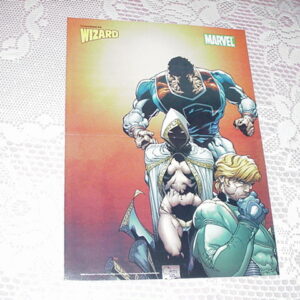
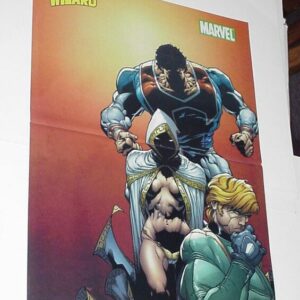
Supreme Power Poster # 1 Joe Quesada Hyperion Doctor Spectrum Squadron
$29.99 Add to cart -
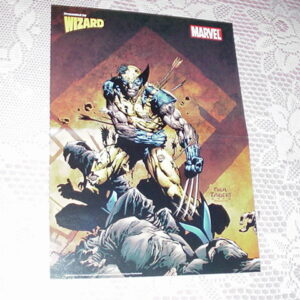
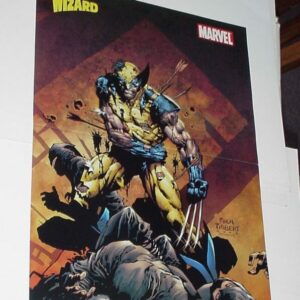
Wolverine Poster #16 vs The Hand The End by David Finch Ninjas
$39.99 Add to cart -
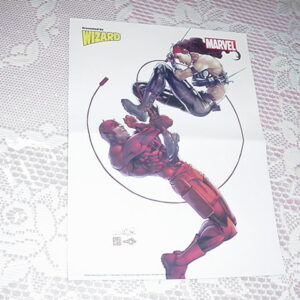
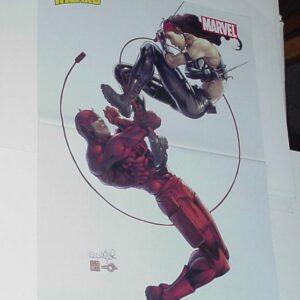
Daredevil vs Elektra Poster Ultimate Salvador Larroca
$29.99 Add to cart -

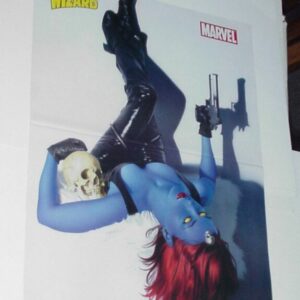
X-Men Poster #35 Mystique Mike Mayhew Skull HOT # 9 Cover
$34.99 Add to cart
